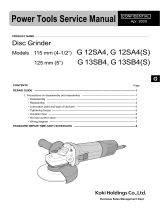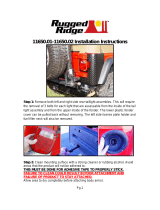*
ALTERNATIVE PARTS--- 2 ---
ITEM
NO.
CODE NO.
DESCRIPTION REMARKS
NO.
USED
PARTS
12 -- 05
G 12SA3
1 320-523 TAPPING SCREW D5X25 (BLACK) 4
2 325-053 GUARD PLATE 1
3 301-944 PUSHING BUTTON 1
4 321-737 GEAR COVER ASS’Y 1 INCLUD. 3, 19
5 949-558 NUT M8 (10 PCS.) 1
6 308-541 PINION 1
7 308-543 SEAL RING (A) 1
8 980-866 WASHER (C) 1
9 629-T12 BALL BEARING 629T12DDC3PS2-L 1
10 957-754 RUBBER RING 1
11 321-734 BEARING COVER 1
*12 360-734U ARMATURE ASS’Y 120V 1 INCLUD. 9, 16, 17
*12 360-734E ARMATURE 230V-240V 1
13 321-732 FAN GUIDE 1
14 982-021 HEX. HD. TAPPING SCREW D4X70 2
*15 340-645D STATOR 120V 1
*15 340-645E STATOR 230V 1
*15 340-645F STATOR 240V 1
16 315-877 DUST SEAL 1
17 608-VVM BALL BEARING 608VVC2PS2L 1
18 303-255
SEAL LOCK SCREW (W/SP. WASHER) M4X10
2
19 301-943 LOCK PIN 1
20 321-736 GEAR 1
21 991-207
SEAL LOCK SCREW (W/SP. WASHER) M4X8
3
22 936-680 BEARING COVER (B) 1
23 620-1DD BALL BEARING 6201DDCMPS2L 1
24 308-546 FELT PACKING 1
25 308-545 PACKING GLAND 1
26 307-046
SEAL LOCK SCREW (W/SP. WASHER) M5X16
4
27 944-109 FEATHER KEY 3X3X8 1
*28 994-301 SPINDLE (A) 1
*28 994-302 SPINDLE (B) 1 FOR USA, CAN
29 949-241 MACHINE SCREW M5X20 (10 PCS.) 1
30 949-454 SPRING WASHER M5 (10 PCS.) 1
31 319-656 WHEEL GUARD ASS’Y 1 INCLUD. 29, 30
*32 937-817Z WHEEL WASHER 1
*32 937-928Z WHEEL WASHER (A) FOR D16 HOLE 1 FOR USA, CAN
33 316-821 D. C. WHEELS 115MM A36Q (25 PCS.) 1
*34 994-324 WHEEL NUT M14 1
*34 937-923P WHEEL NUT 5/8”-11UNC 1 FOR USA, CAN
35 321-735 GEAR AND PINION ASS’Y 1 INCLUD. 6, 20
36 314-428 SLIDE KNOB 1
37 325-050 HOUSING 1
38 321-733 RUBBER RING 1
39 319-319 PUSHING BUTTON SWITCH 1
*40 930-039 NOISE SUPPRESSOR 1 EXCEPT FOR USA, CAN
41 325-051 SLIDE BAR 1
42 999-088 CARBON BRUSH (1 PAIR) 2
43 317-810 BRUSH HOLDER 2
44 308-536 SPRING 2
45 325-054 SWITCH HOLDER 1






















